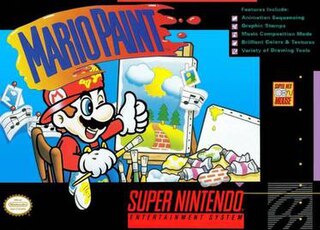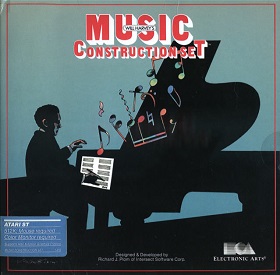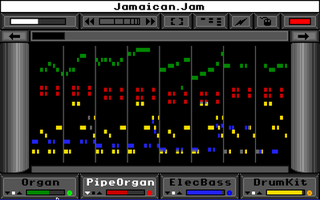Computer music is the application of computing technology in music composition, to help human composers create new music or to have computers independently create music, such as with algorithmic composition programs. It includes the theory and application of new and existing computer software technologies and basic aspects of music, such as sound synthesis, digital signal processing, sound design, sonic diffusion, acoustics, electrical engineering and psychoacoustics. The field of computer music can trace its roots back to the origins of electronic music, and the first experiments and innovations with electronic instruments at the turn of the 20th century.
Electronic music is music that employs electronic musical instruments, digital instruments, or circuitry-based music technology in its creation. It includes both music made using electronic and electromechanical means. Pure electronic instruments depended entirely on circuitry-based sound generation, for instance using devices such as an electronic oscillator, theremin, or synthesizer. Electromechanical instruments can have mechanical parts such as strings, hammers, and electric elements including magnetic pickups, power amplifiers and loudspeakers. Such electromechanical devices include the telharmonium, Hammond organ, electric piano and the electric guitar.

MIDI is a technical standard that describes a communications protocol, digital interface, and electrical connectors that connect a wide variety of electronic musical instruments, computers, and related audio devices for playing, editing and recording music. The specification originates in a paper titled Universal Synthesizer Interface, published by Dave Smith and Chet Wood, then of Sequential Circuits, at the October 1981 Audio Engineering Society conference in New York City.

The Synclavier is an early digital synthesizer, polyphonic digital sampling system, and music workstation manufactured by New England Digital Corporation of Norwich, Vermont. It was produced in various forms from the late 1970s into the early 1990s. The instrument has been used by prominent musicians.

Jef Raskin was an American human–computer interface expert best known for conceiving and starting the Macintosh project at Apple in the late 1970s.

The Apple IIGS, the fifth and most powerful of the Apple II family, is a 16-bit personal computer produced by Apple Computer. While featuring the Macintosh look and feel, and resolution and color similar to the Amiga and Atari ST, it remains compatible with earlier Apple II models. The "GS" in the name stands for "Graphics and Sound," referring to its enhanced multimedia hardware, especially its state-of-the-art audio.
Laurie Spiegel is an American composer. She has worked at Bell Laboratories, in computer graphics, and is known primarily for her electronic-music compositions and her algorithmic composition software Music Mouse. She also plays the guitar and lute.

Cubase is a digital audio workstation (DAW) developed by Steinberg for music and MIDI recording, arranging and editing. The first version, which was originally only a MIDI sequencer and ran on the Atari ST computer, was released in 1989. Cut-down versions of Cubase are included with almost all Yamaha audio and MIDI hardware, as well as hardware from other manufacturers. These versions can be upgraded to a more advanced version at a discount.

A digital audio workstation (DAW) is an electronic device or application software used for recording, editing and producing audio files. DAWs come in a wide variety of configurations from a single software program on a laptop, to an integrated stand-alone unit, all the way to a highly complex configuration of numerous components controlled by a central computer. Regardless of configuration, modern DAWs have a central interface that allows the user to alter and mix multiple recordings and tracks into a final produced piece.

Mario Paint is a video game released in 1992 by Nintendo for use with the Super Nintendo Entertainment System. It is packaged with the Super NES Mouse peripheral. The game was developed by Nintendo Research & Development 1 and Intelligent Systems.
Digital painting is an emerging art form in which traditional painting techniques such as watercolor, oils, impasto, etc. are applied using digital tools by means of a computer, a graphics tablet and stylus, and software. Traditional painting is painting with a physical medium as opposed to a more modern style like digital. Digital painting differs from other forms of digital art, particularly computer-generated art, in that it does not involve the computer rendering from a model. The artist uses painting techniques to create the digital painting directly on the computer. All digital painting programs try to mimic the use of physical media through various brushes and paint effects. Included in many programs are brushes that are digitally styled to represent the traditional style like oils, acrylics, pastels, charcoal, pen and even media such as airbrushing. There are also certain effects unique to each type of digital paint which portray the realistic effects of say watercolor on a digital 'watercolor' painting. In most digital painting programs, the users can create their own brush style using a combination of texture and shape. This ability is very important in bridging the gap between traditional and digital painting.

A MIDI controller is any hardware or software that generates and transmits Musical Instrument Digital Interface (MIDI) data to MIDI-enabled devices, typically to trigger sounds and control parameters of an electronic music performance.
capella is a musical notation program or scorewriter developed by the German company Capella Software AG, running on Microsoft Windows or corresponding emulators in other operating systems, like Wine on Linux and others on Apple Macintosh. Capella requires to be activated after a trial period of 30 days. The publisher writes the name in lower case letters only. The program was initially created by Hartmut Ring, and is now maintained and developed by Bernd Jungmann.
Opcode Systems, Inc. was founded in 1985 by Dave Oppenheim and based in and around Palo Alto, California, USA. Opcode produced MIDI sequencing software for the classic Mac OS and Microsoft Windows, which would later include digital audio capabilities, as well as audio and MIDI hardware interfaces. Opcode's MIDIMAC sequencer, launched in 1986, was the first commercially available MIDI sequencer for the Macintosh computer and one of the first commercially available music sequencers on any commercial computer platform.

Will Harvey's Music Construction Set (MCS) is a music composition notation program designed by Will Harvey for the Apple II and published by Electronic Arts in 1983. Harvey wrote the original Apple II version in assembly language when he was 15 and in high school. MCS was conceived as a tool to add music to his previously published game, an abstract shooter called Lancaster for the Apple II.
Jam Session is the 1988 successor to Studio Session, a 1986 software program for Macintosh computers, for music creation and playback. It was created by Macintosh and Newton pioneer Steve Capps and musician Ed Bogas. Jam Session was published by Broderbund Software. Studio Session was published by Bogas Productions.

Passport Designs Inc. was a software company that created early music production software, such as the pre-MIDI SoundChaser in 1982. Other programs included Master Tracks Pro and Encore.

Instant Music is interactive music software released by Electronic Arts (EA) in 1986. It was developed first for the Amiga, but then ported to other platforms, such as Apple IIGS, and Commodore 64.

Overture is a music notation (scorewriter) program for Windows and Macintosh platforms, written by Don Williams. Visually, the Overture scoring interface resembles Encore, another notation program originally by the same author. Overture was the first scorewriter to feature full Virtual Studio Technology (VST) hosting; the software supports MIDI and audio playback.
Live electronic music is a form of music that can include traditional electronic sound-generating devices, modified electric musical instruments, hacked sound generating technologies, and computers. Initially the practice developed in reaction to sound-based composition for fixed media such as musique concrète, electronic music and early computer music. Musical improvisation often plays a large role in the performance of this music. The timbres of various sounds may be transformed extensively using devices such as amplifiers, filters, ring modulators and other forms of circuitry. Real-time generation and manipulation of audio using live coding is now commonplace.













